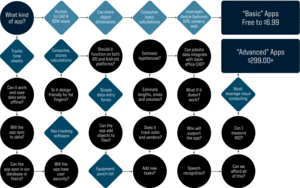
Tablet adoption is exploding on construction sites. Amid the blast radius of that adoption, a new generation of applications is following, many designed by construction firms using in-house teams or partnering with vendors.
"It's the dawn of a new era" in construction technology, says Jason Burns, vice president of technology with New York City-based construction manager Hunter-Roberts Construction. He reckons that 80% of the firm's projects now are using Apple iPads on jobs. Burns also supports other tablet devices for the Android platform as executives request it—but they are nowhere near the steady clip of adoption he's seen with iPads on jobsites.
For Hunter-Roberts, the tablet scenario is rapidly becoming the standard approach to project management. Its methods include building information modeling "kiosks," which are stations with tablets attached that make models available to superintendents and workers to bring up plans and check for clash detection issues in the field.
All this is barely the start. As more construction firms adopt the iPad as a field-management device to document work flows on jobsites for quality assurance/quality control, punch-listing and commissioning, a new wave of apps designed for niche purposes are flowing in. Is this a good thing? Some major software ventdors aren't so sure. Midsize firms say there is a need and a desire to build apps that fill gaps currently not served by enterprise vendors.
Even Apple's own developers see a surge in niche apps for the A/E/C sector, company spokesman Ted Miller confirms. Burns adds, "People are jumping on the bandwagon and programming for more field apps."
There’s a Niche App for That
Julian Clayton, vice president of research and technology at Crescent Construction Services, is one example. The commissioning firm, based in North Carolina and Connecticut, isn't out to compete head-to-head with big providers of enterprise software, such as Vela Systems. He's going after market sectors he doesn't think are being served by them.
Clayton says Vela's software gets overcomplicated for jobs on smaller sites. "I've been on jobsites with guys yelling at each other over how to use it," he says of Vela's punch-listing application.
In his view, Vela is great for large projects that have multifaceted systems to track and document. But Clayton looks at the large number of smaller projects, such as pharmacies, that could use an app that isn't priced for a major enterprise customer. He is targeting a higher volume at a lower price point (See ENR's Sept. cover story: Tablets Take Off in Construction).
Riding a crest of interest, Clayton and his new app-building division have been featured on Apple's own iTunes website, highlighting its PunchList app ($6.99) that helps users flag problems in the design phase and during preconstruction.
Like most apps in the App Store, PunchList also mashes up other apps, such as how it connects with the free, file-sharing web service DropBox for uploading and downloading big files, images and video. He claims it's a much simpler version of other punch-listing apps.
Clayton also just released an app called PourScore, which performs flatness and levelness calculations of floors based on industry standards. It can give users a single score for individual runs and slabs, or users can calculate the required score for the remainder of the slab. This is an example of the niche productivity apps that Clayton says are a "green field" for smaller firms. It's just the start for his team: "We're going at it full steam."
Can They Support It?
All that's fine with Josh Kanner, co-founder and marketing chief of Vela Systems, the Massachusetts-based field-management vendor considered one of the leaders in construction software. For the most part, he shrugs off Clayton's comments. He argues that if a user finds Vela too complicated, it's likely a training issue. "We provide unlimited user access based on the size of your project or companywide deployment. There is no per-seat model," he says. It is unlimited for users at the project or company level, he says.
Kanner agrees the market for niche apps is hot in construction. "It's so early in the world of apps that I'm not sure everybody understands what's out there. I could build my own quality-management system, or I could buy Vela's and know that it's going to be supported," he says.
Support is key to the care and feeding of any major software investment, Kanner says. "[We] have training and a variety of relationships with BIM vendors to have more BIM on the iPad. When companies do their homework [on Vela], they'll quickly see that it's more than an app," he says.
In addition, Kanner says, Vela does field management and provides tools, such as attaching images and documenting them in the app. It works with thousands of free or cheap apps that are useful in construction, such as Box.Net or DropBox for uploading images and big files of jobsite plans for markup.
There's a big difference between low-cost apps and those that are fully supported, Kanner adds. "We come out with a new upgrade every 30 to 45 days [in the Apple App Store]," he says. "In the old days, using Windows-based tablets, that would have been impossible because each user download came with an installer. At some firms you might have to get your IT staff involved. But in the new app world, you can deploy and upgrade in a much easier and seamless way."



Post a comment to this article
Report Abusive Comment